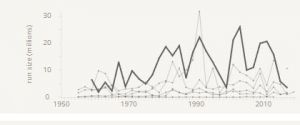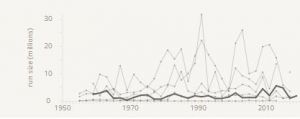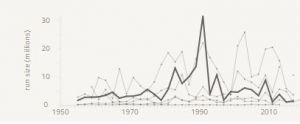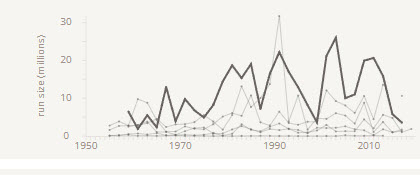Catch again: In a previous reLAKSation, I raised the question as to why there is a significant discrepancy between the number of wild fish caught and reported to Marine Scotland Science (MSS) for inclusion in the official statistics and those recorded in the Fisheries Management Scotland (FMS) annual review. For the 34 districts recorded in the FMS review, over 1,000 more fish were reported than appeared in the official statistics.
Given that FMS have called for action over concerns about the lowest ever recorded catch in Scotland, surely the first action is to ensure that the catch data recorded is accurate, so the true state of the populations of salmon and sea trout can be estimated? How can the plight of these fish be gauged if there are such huge discrepancies in the numbers of fish reported?
If all that is required is that every angler fishing in a defined fishery reports the number and estimated size or weight of the fish they caught to the proprietor and then this information is sent on to MSS when requested and also to the local Salmon Fishery Board if required, then how can there be such discrepancies? Surely two fish, for example, caught in a specific fishery on a certain day will remain two fish regardless of whether that information is sent to MSS as required by law, or the local fishery board if requested?
The wild fish sector has demanded that the salmon farming industry should be more transparent with the publication of huge amounts of data, often on a weekly basis, yet the wild sector continues to report data on an annual basis and still on a paper form that is sent out to them. Catches are eventually published, often as long as eighteen months after the fish were caught. A recent FOI request has revealed that IT consultants have now been commissioned to look at various options to modernise the system, but it would seem unlikely that any new system will be in place for next year’s fishing season. We are therefore left relying on this archaic system of reporting that is clearly susceptible to major errors.
Since my original comments failed to ring any alarm bells – certainly no one asked how I arrived at the figures I revealed, I submitted another FOI request to try to understand why this discrepancy exists.
I was informed that every year about 2,100 forms are sent out to Scottish salmon fisheries to be completed and returned. Under the 2003 Fisheries (Consolidation) Act, it is an offence for a fishery not to report the catch when Ministers ask them to do so or to make a false return. Despite it being an offence, over recent years about 10% of the forms are not returned. This has prompted a further FOI request to ask how many of the fisheries that have failed to return forms have been subjected to the law. I suspect the answer is none, as this is salmon angling that is being discussed here. After all, fishing is more of a gentleman’s club than a real business.
Although there are 109 fishery districts in Scotland, there are only 41 salmon fishery boards – some boards cover more than one district. However, 13 fishery districts do not have a board and for these, the Minister (Marine Scotland) takes on the responsibility of the board. In their response, the Scottish Government says that the salmon fishery boards have the legal power to collect data independently of the official statistics but not all do, preferring to rely on the data made available in the official statistics. The reply says that it is inevitable that there could be discrepancies between the data collected for the official statistics and any data collected by the fishery boards. The reasons they give is that:
- Some fisheries may occasionally report their catches to one organisation but not to the other.
However, if they did, the one organisation must be the Scottish Government because fisheries are legally obliged to do so in which case the numbers should be higher in the official statistics than in the fishery board reports, but the problem highlighted is that figures from the fishery boards in the FMS annual review are higher than in the official statistics.
- It is possible that the Scottish Government and the fishery boards hold different records for the fisheries contacts
As it is a legal requirement for fisheries to submit catch returns, then surely it must also be a requirement for their contact details to be kept up to date. How can the fishery boards be receiving catch data from their member fisheries that is not being submitted to the Scottish Government? This would seem extremely unlikely but as there is such a large discrepancy, then surely someone in Marine Scotland should be requesting the data from the fishery boards and double checking regardless? However, I am told in the response that Marine Scotland do not have a role in checking other organisation’s data.
- The FOI response says that Marine Scotland does receive data after the cut-off date for inclusion in the statistics. This would be updated the following year.
Surely, such late returns are unacceptable. How long does a fishery owner need to count the few fish caught on their beats? It seems that in some cases, it takes many weeks.
- Whilst Marine Scotland’s role is not to check the data produced by other organisations, some fishery boards do check their data against that published in the official statistics and contact Marine Scotland Science if the official statistics appear to be missing some data.
The FOI response stresses that the reason for doing this is because the fishery boards could be concerned that their fisheries might be downgraded in terms of the future river grading under the conservation regulations. Thus, a fishery might be graded as a 3 rather than a 2 and this might be less appealing to prospective anglers wanting to buy a day or weeks fishing. In this case Marine Scotland are prepared to check the data.
I have identified a discrepancy of more than 1,000 fish between the catch data published by Fisheries Management Scotland and that in the official statistics. Yet no-one in the wild fish sector nor the Scottish Government seems remotely interested in finding out why. At the same time, no-one seems that bothered if fisheries do not complete and return their forms as required to do so. It’s not surprising that the wild fish stocks are so much under threat with such a lax attitude to recording and collecting the data. It seems madness that in such modern times, real time recording of accurate salmon and sea trout catch data is still unavailable.
Salmon Wars: It is only necessary to read the dedication of the new book ‘Salmon Wars’ to understand the tone of this 355-page book. This reads ‘In memory of Paul Collins, a dedicated fly fisherman’.
The authors of the book, Douglas Frantz and Catherine Collins, describe how following a public meeting near their home, in which they heard from environmentalists, lobster fishermen and ordinary folks objecting to plans for a salmon farm, they spent two years trying to understand the impact of open-net farms on the health of the planet and its people.
Clearly, the book reveals a journey in which the authors spoke to anyone and everyone who might hold a negative view on salmon farming. It is a very one-sided story. The authors did try to contact a couple of farming companies but any reluctance to respond to written questions on their part are understandable. The book’s intended message was never in doubt.
The authors say their primary sources were interviews, news and research articles, public meetings and thousands of pages of court records and government documents. These works of scientists, researchers and journalists influenced their thinking and contributed to their conclusions, yet I am left wondering whether these authors became so focused on their message, that they didn’t understand what they had either heard or read.
My interest is the interaction between farmed salmon and wild and thus my focus on the book will be on this subject. Over the years, there have been a number of claims made against farmed salmon and especially about the spread of sea lice and any interbreeding with wild. Strangely, sea lice hardly get a mention in this book except odd unsubstantiated sentences such as “infestations of sea lice originating on farms kill young wild salmon in large numbers”.
However, it was a few sentences about interbreeding that really attracted my attention: ‘Wild Pacific salmon and farmed Atlantic salmon are genetically different’. Well of course they are – they are different species. Then after talking about wild salmon being adapted to life in the wild and farmed salmon not, the authors state that ‘The negative effects of this divergence are well documented’ although they do not refer to even one example. They continue ‘Studies have showed that the interbreeding of farm salmon with wild salmon lowers the fitness of the hybrid offspring, weakens their ability to survive and eventually reduces the overall wild population’. My first thought was whether they had confused Pacific and Atlantic salmon, but their claims were clarified in the next sentence: ‘Biologists studying salmon escapes fear the farmed version will eventually displace wild salmon particularly in places like the Pacific North-West where wild salmon are in decline’.
Their meaning could not be any clearer, although the authors do not identify the biologists or their institutions that are the source of this research showing the interaction between farmed Atlantic salmon and wild Pacific species. This brings into question whether any such research exists at all? By comparison, the Pacific Salmon Foundation say that whilst Pacific salmon are distantly related to Atlantic salmon, they cannot inter-breed as these species have different numbers of chromosomes. Despite this inconvenience, the authors of the book state that ‘there is ample evidence that the two species interbreed’, but such evidence is conspicuously missing from this book.
According to Frantz & Collins, farmed Atlantic salmon are also genetically different from wild Atlantic salmon which they say means escapes from farms pose similar dangers with farmed salmon interbreeding with wild Atlantic salmon. Farmed and wild Atlantic salmon are in fact virtually identical, after all they are the same fish. However, markers on the chromosomes do differ which helps in identification.
There is genetic variation between all wild Atlantic salmon otherwise they would be clones. Such variation is the basis of natural inheritance which it is why it exists. Of course, such variation can be selected to assist in the farming process, but as salmon farming is still in its infancy, farmed salmon are still in effect the same fish as those in the wild. The story of interbreeding is just one part of a wider narrative aimed at undermining the existence of the salmon farming industry. The reality is that the authors have simply failed to understand the explanation related to them. They probably expect that those reading their book to be as equally uninformed and unlikely to pick up on any of their errors and there are plenty to be found.
I feel that it is worth mentioning one of the references to Alex Morton in this book. The book states that ‘applying science and rational thought, Morton found a classic example of a food chain being disrupted in three distinct phases’. The first is the sea lice weakened and killed juvenile wild salmon reducing the number of young fish that made it to the ocean. The second phase is that fewer adult salmon return to the rivers to spawn and on this, the authors say the data was clear. They cite that ‘In 2002, Government scientists predicted that 3.6 million pink salmon would return to the Broughton Archipelago from their ocean migration – the actual number was less than 150,000’. Alex Morton’s third phase, according to the book, is that killer whales didn’t have enough salmon to eat so they left to find food elsewhere.
The reference to 2002, is typical of this book, providing a narrative of something that happened many years ago but failing to follow through to see what happened more recently. The returns of Pinks do fluctuate but the graph taken from Pacific Salmon Explorer shows that whilst 2002 was a poor year, the Pinks subsequently bounced back. The authors of the book leave readers with the impression that Pink salmon numbers have crashed as a result of salmon farming yet clearly, this is not the case.

Pink salmon returns around Vancouver Island also seem to have shown an increase since 2002 despite the presence of salmon farms, although numbers are much smaller than for the Fraser River as a whole.

By comparison, the Skeena River, which is much further North than the Fraser and is an area where salmon farming is absent has shown a collapse of Pink salmon numbers.

Clearly, there are much greater influences on Pink numbers than salmon farming but sadly this book chooses to ignore the wider issues affecting wild salmon. The authors had already made up their mind about salmon farming long before their book was published, and it seems that they weren’t interested in any additional facts that might undermine their anti-salmon farm narrative.
My comments relate to just one tiny part of the book, however anyone diving into other sections will encounter many other errors and misunderstandings. This will come as no surprise.

